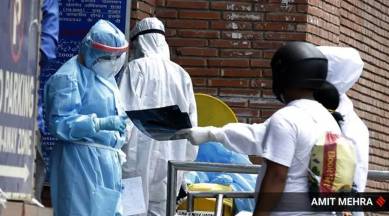Stay updated with the latest - Click here to follow us on Instagram
Covid-19 cases surge 10-fold in state in 25 days
Talking to The Indian Express, medical experts claimed that the behaviour of viruses evolve with the change of seasons especially between January-April and September-November —when the cases of influenza and swine flu also surge.

In the first 25 days of this month, the active caseload of Covid-19 has surged by 10-fold — the highest spike recorded in the last four months in Maharashtra. The efflux of the infection, which was limited within major cities like Mumbai, Pune and Thane in the first two weeks, has now started spreading across other districts.
On March 1, the state had 198 active Covid-19 cases, which within just 25 days climbed to 1,956 as of March 25. A letter from the Centre on March 25 stated that Maharashtra shares 21.7 per cent of India’s active Covid patients — second highest after Kerala.
Pune tops the chart with 571 active patients, followed by Mumbai (487) and Thane (348). These three cities with a high floating population always report a high infection rate.
However, as per the state’s report, neighbouring districts like Raigad, Kolhapur, Solapur, Nashik, Aurangabad and Amravati have also witnessed rapid increase in Covid cases. For instance, on March 1, the rural district of Amravati had only one active case, which increased to 38 on March 25. In the first week of March, out of the 36 districts, 17 had zero active cases. But with the gradual spread of the virus, as of March 25, only five districts — Hingoli, Washim, Bhandara, Gondia and Gadchiroli recorded zero cases.
Talking to The Indian Express, medical experts claimed that the behaviour of viruses evolve with the change of seasons especially between January-April and September-November —when the cases of influenza and swine flu also surge. “With the gained herd immunity through acquired infection and mass vaccination, we wouldn’t witness an outbreak of Covid-19. But annually, we will witness a sudden spike in cases with the change of seasons which is quite normal when a pandemic turns into an endemic,” said Dr Pradip Awate, the former state surveillance officer.
Recently, a new variant — XBB.1.16 — a recombinant of two Omicron sub-variants has turned into a new concern. Data from India’s Sars-CoV-2 genome sequencing consortium INSACOG showed that a majority of the XBB.1.16 isolated are from Maharashtra. Doctors believe that it is unlikely to cause a big wave like the one seen in January 2022 when Omicron first came to India. Dr Rahul Pandit, Chair – Critical Care, Sir HN Reliance Foundation Hospital, said, “It might contribute in a slight rise in cases but won’t overwhelm the healthcare system as seen in the last waves.”
As a precautionary measure, the public health department has directed all the districts to be well prepared for handling Covid and influenza cases.